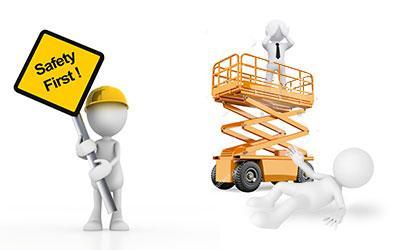Everything you need to know about safety harnesses for your mobile elevating work platform
When you or your employees start working with a mobile elevating work platform, fall protection is vital. Mobile elevating work platforms are mobile and fast, but also dangerous if the appropriate safety measures aren't taken. By means of fall protection, you can explore altitudes in a safe way, without sustaining injuries or other bodily damage. The fall is arrested, resulting in less severe consequences.
WHAT IS FALL PROTECTION?
 Fall protection provides you and your employees with the necessary slack and freedom of movement in order to successfully complete jobs. In addition, it also protects you should you still fall. Fall protection is personal protective equipment (PPE) that is composed of the following parts:
Fall protection provides you and your employees with the necessary slack and freedom of movement in order to successfully complete jobs. In addition, it also protects you should you still fall. Fall protection is personal protective equipment (PPE) that is composed of the following parts:
- full body harness (A)
- anchor devices (B)
- coupling or connecting devices (C)
A full body harness or safety harness is the first link in the safety process. This harness safely holds you or your employee during and after a fall. This always needs to be worn in environments that present a fall risk, the type depends on the precise nature of the work activities. E.g. the location of the anchor device has a major influence on the freedom of movement. But other factors can also play a role in the choice of the harness, such as accessories, life span and elasticity of the harness, resistance against oils and greases …
Even the way in which you put on such a harness is very specific. For instance, you always need to check the fall indicators to make sure that the harness is still in good condition. Discover how you can do this and what other steps you need to follow in this video.
Anchor devices form the connection between the connecting device and the tie-off point. These are anchor points that act as an attachment point of the safety system. An example of this is a horizontal rail system.
Coupling or connecting devices connect the harness to the anchor device. An example of this is a shock-absorbing lanyard. If one of the three before-mentioned links is missing, or is insufficiently strong, the safety can no longer be guaranteed.
WHAT IS THE LEGISLATION AROUND FALL PROTECTION FOR MOBILE ELEVATING WORK PLATFORMS?
 The European legislation declares that protective measures must be taken when working at altitude. Furthermore, user manuals of work equipment always need to be observed closely. Nearly all manufacturers of mobile elevating work platforms lay down the use of fall protection in their user manuals, so fall protection for mobile elevating work platforms is indeed mandatory.
The European legislation declares that protective measures must be taken when working at altitude. Furthermore, user manuals of work equipment always need to be observed closely. Nearly all manufacturers of mobile elevating work platforms lay down the use of fall protection in their user manuals, so fall protection for mobile elevating work platforms is indeed mandatory.
Most European countries also have an own national legislation with regard to working at altitude. This legislation stipulates as of what height measures are required. This level differs from one country to another. In Belgium, this starts from 2 metres, while in the Netherlands it starts from 2,5 metres, and in France no minimum height is even stipulated. This means that - in France - as soon as there is a risk of falling, protection is required.
Even for the technical inspection of fall protection equipment, laws exist. These stipulate that your safety harness must be inspected on a regular basis, depending on the legislation in each country. E.g. for Belgium, this means once a year. After a fall, you immediately need to subject the equipment to a new inspection. Next, you need to have the fall protection equipment repaired and re-inspected.
TRAINING FALL PROTECTION
 A safe environment starts with yourself. Under the motto ‘better safe than sorry’, we recommend to always provide the necessary training courses. TVH Academy provides a general driver training for mobile elevating work platforms. During this training, the topics safety and fall protection are always discussed.
A safe environment starts with yourself. Under the motto ‘better safe than sorry’, we recommend to always provide the necessary training courses. TVH Academy provides a general driver training for mobile elevating work platforms. During this training, the topics safety and fall protection are always discussed.
Even after a thorough training, it is very important that you and your employees remain attentive to any risks of falling. Pictograms on the shop floor can be a useful reminder.
WHAT IF THINGS STILL GO WRONG?
 Should you fall off a mobile elevating work platform nevertheless, you can only dangle for 15 to 20 minutes before serious consequences. After this period, the blood circulation in the legs gets cut off, which can lead to a suspension trauma or harness hang syndrome (HHS) and - in the worst case - even death.
Should you fall off a mobile elevating work platform nevertheless, you can only dangle for 15 to 20 minutes before serious consequences. After this period, the blood circulation in the legs gets cut off, which can lead to a suspension trauma or harness hang syndrome (HHS) and - in the worst case - even death.
So, in addition to fall protection, an evacuation plan is also a crucial element of safe mobile elevating work platform use. So never operate a mobile elevating work platform alone! Always make sure that a colleague is nearby who can evacuate you or your employee in case of a fall.
Not only fall protection and an evacuation plan will help you and your employees to safely work with a mobile elevating work platform. An inspection of the mobile elevating work platform and the shop floor can also assist with this. But that is not all: discover 7 tips to safely work at altitude here.
Stay safe!
Ingeborg, TVH blogger
